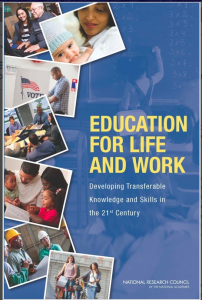Pellegrino, J.W. & Hilton, M.L. (Eds.). (2012). Education for Life and Work: Developing Transferable Knowledge and Skills in the 21st Century. Washington, DC: The National Academies Press.
After conducting extensive interdisciplinary research on behalf of The National Research Council, several committees of experts in education, psychology, evaluation, sociology, physics, astronomy, geology, learning sciences, and cognitive science recommended the following 21st century teaching practices:
o Using multiple and varied representations of concepts and tasks, such as diagrams, numerical and mathematical representations, and simulations, combined with activities and guidance that support mapping across the varied representations.
o Encouraging elaboration, questioning, and explanation—for example, prompting students who are reading a history text to think about the author’s intent and/or to explain specific information and arguments as they read—either silently to themselves or to others.
o Engaging learners in challenging tasks, while also support- ing them with guidance, feedback, and encouragement to reflect on their own learning processes and the status of their understanding.
o Teaching with examples and cases, such as modeling step-by- step how students can carry out a procedure to solve a problem and using sets of worked examples.
o Priming student motivation by connecting topics to students’ personal lives and interests, engaging students in collaborative problem solving, and drawing attention to the knowledge and skills students are developing, rather than grades or scores.
o Using formative assessment to: (a) make learning goals clear to students; (b) continuously monitor, provide feedback, and respond to students’ learning progress; and (c) involve students in self- and peer assessment.
SOURCE: Pellegrino & Hilton, 2012, pp. 9-10.


